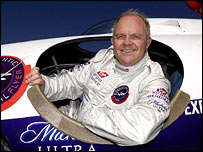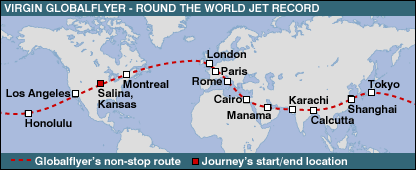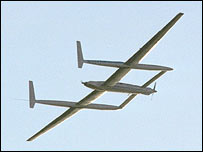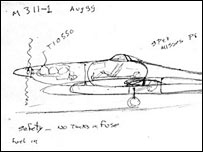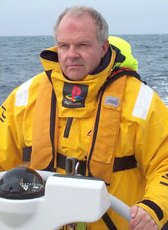|
STEVE FOSSETT - GLOBAL FLYER 1 Feb 2005 |
||||||||||||
|
HOME SITE INDEX CATAMARAN HULL SOLAR PANELS ELECTRIC MOTORS BATTERIES CREW EXPEDITION SPONSORS |
||||||||||||
|
Fossett ready for non-stop tour
Some time this month, 60-year-old thrill-seeker Steve Fossett plans to climb into the small cockpit of an experimental jet aircraft and attempt to fly around the world without refuelling, without company and without sleeping.
To make the voyage before delirium sets in, Fossett needs to fly fast. But to set the record for the first non-stop solo flight around the world, he cannot take any shortcuts either. The Virgin Atlantic-backed GlobalFlyer, a gangly and delicate aircraft designed under the keen eye and artistic hand of Burt Rutan, was built with these two goals in mind. Rutan has tackled this problem before. Nearly two decades ago, Rutan and his team at their California-based Scaled Composites company built an aeroplane named Voyager.
Fossett has collected many world records
It was flown by Rutan's own brother, Dick, and co-pilot Jeane Yeager. The pair took the vehicle around the world using only the fuel it carried at take-off. It was a difficult, but successful journey. "Voyager was so fragile, so dangerous," Dick Rutan said in an interview. "I don't think the Voyager could have made it if we tried 100 more times." The plane, which now hangs in the Smithsonian Air and Space Museum in Washington, DC, served as a model when Rutan started working on an even more challenging solo-pilot design.
Riding a river of wind
Like Voyager, GlobalFlyer is a three-hulled vessel crafted from a graphite-epoxy composite. Fuel compartments are crammed inside the twin outer booms. Both planes have wingspans suitable for a Boeing 737 - Voyager's measures 110ft (33.5m), GlobalFlyer's is 114ft (35m).
Designed to minimise drag, the wings change shape during flight, sagging under the weight of the fuel during take-off, flexing upward during ascent and flattening at cruise altitude. Rather than Voyager's twin piston engines, however, GlobalFlyer has a single turbofan jet engine more commonly used to zip lightweight business jets, such as Cessna Citation Jets and Raytheon Premiers, through the skies.
To feed the turbofan engine, which consumes more fuel than Voyager's piston engines, GlobalFlyer will have to carry nearly three times the amount of fuel of its predecessor. "We're 83% fuel at take-off," GlobalFlyer chief engineer and test pilot Jon Karkow told the BBC News website. "Most every internal part of the plane is filled with fuel."
Despite the bigger fuel load, GlobalFlyer will fall short of its range without an additional push from the jet stream, a naturally occurring high-altitude horizontal wind that moves between 50 and 100 knots (90-180km/h).
But the team decided to look inland, just in case the fuel runs low and Fossett has to touch down short of his mark. Take-off and landing are now targeted for Salina, Kansas. The team plans one more test flight - 23 already have been completed - before attempting the first solo, unrefuelled, around-the-world mission. The flight, which has been repeatedly delayed, is now scheduled to take place no earlier than 8 February.
It will have to be an ideal day, with almost no air turbulence from ground level up to 45,000ft, and no chance of ice formation - the plane has no de-icing equipment. That said, engineers would like it to be a cold day, as cooler temperatures make for denser air and an easier take-off. "It will take off at the structural margin [of the aircraft]," said Karkow. "The reserve strength is not very much."
Added crew chief Philip Grassa: "There's only so much runway. It's a matter of finding good air." If Fossett has to abort the take-off, he will have little room to navigate. The Salina runway is 12,300ft (3,750m) long and has a 1,000ft (300m) overrun. "The airplane might not appreciate it too much if it goes into the rough," Karkow said. "GlobalFlyer is very demanding of the pilot. He will have to be very alert and very skilled at handling the controls."
Rutan's brother, Dick, completed the challenge in Voyager, with Jeane Yeager
Alone, but hardly forgotten
Though no one will be sharing GlobalFlyer's seven-foot cabin with Fossett, he will have plenty of contact with the outside world. Virgin Atlantic Airways, which paid for the plane, has arranged for a US space agency (Nasa) video feed to be relayed through its television satellites.
Parts of the flight may be televised live; other film will be used for a documentary on the project. Fossett also will have an Iridium satellite phone and text messaging system, and, at times, a partner in the sky: his own high-speed Cessna Citation 10 jet.
Aboard this craft will be Fossett's backup pilot and financier, Virgin Group Chairman, Sir Richard Branson, who plans to conduct live interviews with Fossett throughout the flight. Flight controllers also will be monitoring Fossett to make sure he does not fall asleep. The plane is equipped with autopilots, but Fossett needs to be alert to monitor the equipment. For three days - perhaps longer - Fossett will have to get by with 10- to 15-minute catnaps.
GlobalFlyer concept from designer Burt Rutan
AROUND THE WORLD
To set the record, Fossett will have to fly faster and higher than any previous flights, including the 1986 flight of Voyager. If Fossett is successful, he could break between three and seven different records.
After take-off from Kansas, GlobalFlyer will head east, following the jet stream winds over the Atlantic Ocean to the United Kingdom. From there, Fossett will head southeast across the Mediterranean and the Gulf before turning east toward Pakistan, India, China and Japan. The final leg of the journey will be over the Pacific Ocean toward Hawaii, then across the west coast of the United States and back to Kansas.
Major cities along the route include Montreal, London, Paris, Rome, Cairo, Manama, Karachi, Calcutta, Shanghai, Tokyo, Honolulu and Los Angeles.
A SMALL WORLD
Fossett's appetite for adventure is unbounded. An American millionaire who made his fortune trading in the high-risk commodities market, Fossett is best known for his 2002 solo voyage around the world in a hot-air balloon.
It was just the latest for a man who has circumnavigated the globe in boats, aeroplanes and balloons. At the last count, he holds some 60 or more world records. "The endurance aspects make it very interesting to me," Fossett said in interview for the GlobalFlyer.com website. "I am in it for the accomplishment, for doing a unique aviation feat that very few pilots could do," he said. "The hallmarks of aviation are that solo flights are ranked higher than crew flights just because of the difficulty and the level of self-reliance required."
Steve Fossett, the 60 -year-old American millionaire and his crew of 12, sailed into the record books at around 1600 BST on Monday 5th April 2004. The 125-foot catamaran Cheyenne shaved almost six days off the existing record after crossing the official start and finish line at Le Stiff lighthouse on Ouessant.
AWARDS
Gold Air Medal, Federation Aeronautique Internationale, 2002
Explorers Medal, The Explorers Club, 2003
Medaille de l'Aeronautique, France, March 2003
Grand Medaille de l'Aero Club de France, March 2003
Gold Medal, The Royal Aero Club of the United Kingdom, April 2003
Prix De La Vaulx, Fédération Aéronautique Intérnationale, 1995, 1997,1998 and 2002.
Prix de l'Aventure Sportive, Academie des Sports, France, March 2002
Rolex Yachtsman of the Year, U.S. Sailing Association, 2001
Balloon and Airship Hall of Fame, FAI-CIA, Inducted June 1997
Silver Buffalo, Boy Scouts of America, May 1999
Distinguished Eagle Scout, Boy Scouts of America, May 1998
Harmon Trophy, National Aeronautic Association, October 1998
Distinction in Exploration, National Geographic Society, November 1998
Victor Award (Special), Victor Sports Awards, July 1995 and June 1997
Diplome de Montgolfier, Fédération Aéronautique Intérnationale, March 1996
Hall of Fame, Aviation Week ans Space Technology, Laureate for Operations, March 2003
Steve Fossett
HONORARY MEMBERSHIPS
Aero Club de France
National Yacht Club of Ireland
Academie Nationale de l'Air et de l'Elspace
Yacht Club de France (2001-02)
Circumnavigators Club
The Adventurers Club
Newport Harbor Yacht Club
Royal Temple Yacht Club
Canterbury (NZ) Gliding Club
GLOBAL FLYER LINKS:
Home Latest News About the Attempt About the Aircraft Steve Fossett Sir Richard Branson
About the Aircraft Steve Fossett Biography Richard Branson Biography Virgin Atlantic
Kansas start for Virgin attempt 06 Dec 04 | Science/Nature SpaceShipOne rockets to success 04 Oct 04 | Science/Nature Burt Rutan: Aviation pioneer 04 Oct 04 | Science/Nature Hopes soar for solo record plane 14 Aug 04 | Science/Nature Testing begins for global plane 12 Mar 04 | Science/Nature Wraps come off solo record plane 08 Jan 04 | Science/Nature
BBC
News Front Page
| Africa
| Americas
| Asia-Pacific
| Europe
| Middle
East | South
Asia
|
||||||||||||
|
||||||||||||
